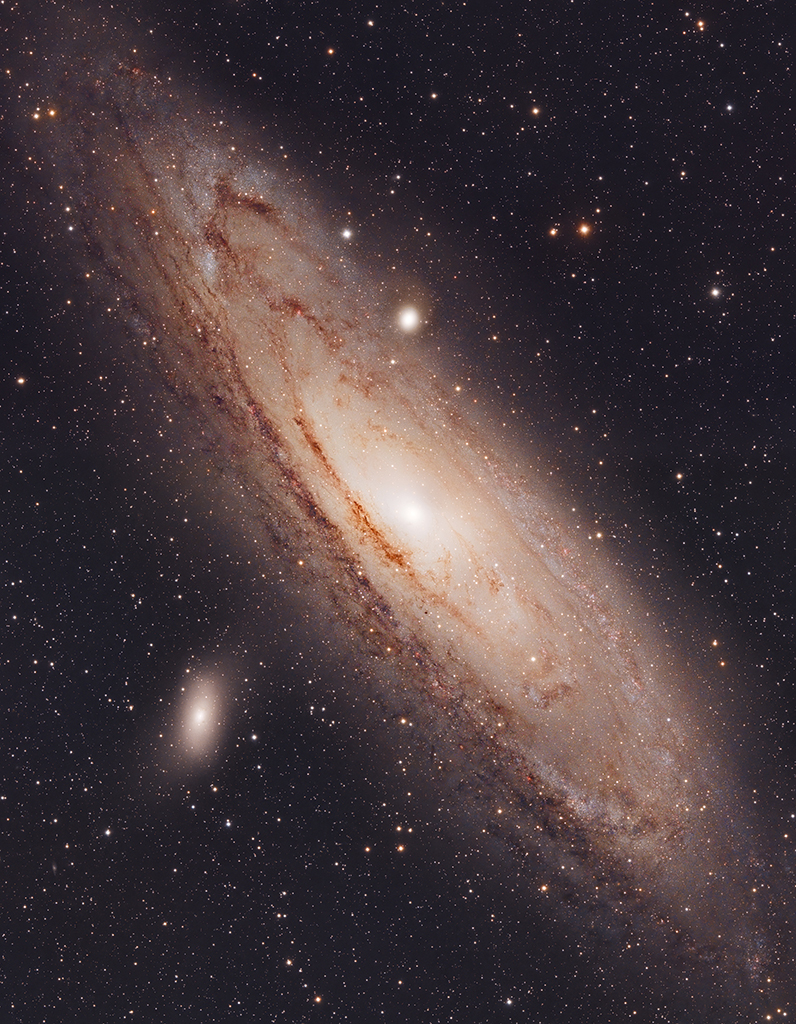Blog
The Andromeda Galaxy, also known as Messier 31, is one of the most observed and photographed objects in the night sky. It’s a spiral galaxy like our Milky Way at a distance of 2.5 million light-years.

Paul Frederic Simon (born October 13, 1941) is an American musician, singer, songwriter and actor. Simon’s musical career has spanned over six decades. He reached fame and commercial success as half of the duo Simon & Garfunkel, formed in 1956 with Art Garfunkel. Simon wrote nearly all of their songs, including US number-one singles “The Sound of Silence“, “Mrs. Robinson“, and “Bridge over Troubled Water“.
After Simon & Garfunkel split up in 1970, at the height of their popularity, Simon began a successful solo career. He recorded three acclaimed albums over the following five years. In 1986, following a career slump, he released Graceland, an album inspired by South African township music, which sold 14 million copies worldwide and remains his most popular solo work. Simon also wrote and starred in the film One-Trick Pony (1980) and co-wrote the Broadway musical The Capeman (1998) with the poet Derek Walcott. On June 3, 2016, Simon released his 13th solo album, Stranger to Stranger, which debuted at number one on the Billboard Album Chart and the UK Albums Chart.
Simon has earned sixteen Grammy awards for his solo and collaborative work, including three for Album of the Year (Bridge Over Troubled Water, Still Crazy After All These Years, and Graceland), and a Lifetime Achievement Award. He is a two-time inductee into the Rock and Roll Hall of Fame: first in 1990 as a member of Simon & Garfunkel and again in 2001 for his solo career. In 2006 he was selected as one of the “100 People Who Shaped the World” by Time. In 2011, Rolling Stone named Simon one of the 100 greatest guitarists, and in 2015 he was ranked eighth in their list of the 100 Greatest Songwriters of All Time.[9] Simon was the first recipient of the Library of Congress‘s Gershwin Prize for Popular Song in 2007.
Simon was born on October 13, 1941, in Newark, New Jersey, to Hungarian-Jewish parents. His father, Louis (1916–1995), was a college professor, double-bass player, and dance bandleader who performed under the name “Lee Sims”. His mother, Belle (1910–2007), was an elementary school teacher. In 1945, his family moved to the Kew Gardens Hills section of Flushing, Queens, in New York City.
more...Pharoah Sanders (born Farrell Sanders, October 13, 1940) is an American jazz saxophonist. A member of John Coltrane‘s groups of the mid-1960s, Sanders is known for his overblowing, harmonic, and multiphonic techniques on the saxophone, as well as his use of “sheets of sound“. He has released over 30 albums as a leader and has collaborated extensively with Leon Thomas, Alice Coltrane and Tisziji Muñoz, among others. Saxophonist Ornette Coleman described him as “probably the best tenor player in the world”.
Sanders’ music has been called “spiritual jazz” due to his inspiration in religious concepts such as Karma and Tawhid, and his rich, meditative aesthetic. This style is seen as a continuation of Coltrane’s work on albums such as A Love Supreme. As a result, Sanders is considered a disciple of Coltrane or, as Albert Ayler said, “Trane was the Father, Pharoah was the Son, I am the Holy Ghost”.
Pharoah Sanders was born on October 13, 1940, in Little Rock, Arkansas. His mother worked as a cook in a school cafeteria, and his father worked for the City of Little Rock. An only child, Sanders began his musical career accompanying church hymns on clarinet. His initial artistic accomplishments were in the visual arts, but when he was at Scipio Jones High School in North Little Rock, Sanders began playing the tenor saxophone. The band director, Jimmy Cannon, was also a saxophone player and introduced Sanders to jazz. When Cannon left, Sanders, although still a student, took over as the band director until a permanent director could be found.
During the late 1950s, Sanders would often sneak into African-American clubs in downtown Little Rock to play with acts that were passing through. At the time, Little Rock was part of the touring route through Memphis, Tennessee, and Hot Springs for R&B and jazz musicians. Sanders found himself limited by the state’s segregation and the R&B and jazz standards that dominated the Little Rock music scene.
After finishing high school in 1959, Sanders moved to Oakland, California, and lived with relatives. He briefly attended Oakland Junior College and studied art and music. Once outside the Jim Crow South, Sanders could play in both black and white clubs. His Arkansas connection stuck with him in the Bay Area with the nickname of “Little Rock.” It was also during this time that he met and befriended John Coltrane.
more...Leon Konitz (October 13, 1927 – April 15, 2020) was an American composer and alto saxophonist.
He performed successfully in a wide range of jazz styles, including bebop, cool jazz, and avant-garde jazz. Konitz’s association with the cool jazz movement of the 1940s and 1950s includes participation in Miles Davis‘s Birth of the Cool sessions and his work with pianist Lennie Tristano. He was one of relatively few alto saxophonists of this era to retain a distinctive style, when Charlie Parker exerted a massive influence. Like other students of Tristano, Konitz improvised long, melodic lines with the rhythmic interest coming from odd accents, or odd note groupings suggestive of the imposition of one time signature over another. Other saxophonists were strongly influenced by Konitz, such as Paul Desmond and Art Pepper.
He died during the COVID-19 pandemic due to complications brought on by the disease.
Leon Konitz was born on October 13, 1927, in Chicago to Jewish parents of Austrian and Russian descent. At the age of eleven, Konitz received his first clarinet. However, he later dropped the instrument in favor of the tenor saxophone. He eventually moved from tenor to alto. His greatest influences at the time were the swing big bands he and his brother listened to on the radio; hearing Benny Goodman on the radio was what prodded him to ask for a clarinet. He improvised on the saxophone before learning to play standards.
more...Raymond Matthews Brown (October 13, 1926 – July 2, 2002) was an American jazz double bassist known for extensive work with Oscar Petersonand Ella Fitzgerald.
Ray Brown was born October 13, 1926 in Pittsburgh, Pennsylvania and took piano lessons from the age of eight. After noticing how many pianists attended his high school, he thought of taking up the trombone but was unable to afford one. With a vacancy in the high school jazz orchestra, he took up the upright bass.
A major early influence on Brown’s bass playing was Jimmy Blanton, the bassist in the Duke Ellington band. As a young man Brown became increasingly well known in the Pittsburgh jazz scene, with his first experiences playing in bands with the Jimmy Hinsley Sextet and the Snookum Russell band. After graduating high school, having heard stories about the burgeoning jazz scene on 52nd Street in New York City, he bought a one-way ticket to New York. He arrived in New York at the age of 20, met up with Hank Jones, with whom he had previously worked, and was introduced to Dizzy Gillespie, who was looking for a bass player. Gillespie hired Brown on the spot, and he soon played with such established musicians as Art Tatum and Charlie Parker. In 1948, Brown left Dizzy’s band to start a trio with Hank Jones and Charlie Smith.
more...Arthur Tatum Jr. (/ˈteɪtəm/, October 13, 1909 – November 5, 1956 Toledo,OH) was an American jazz pianist who is widely regarded as one of the greatest in his field.
Tatum grew up in Toledo, Ohio, where he began playing piano professionally and had his own radio program, rebroadcast nationwide, while still in his teens. He left Toledo in 1932 and had residencies as a solo pianist at clubs in major urban centers including New York, Chicago, and Los Angeles. Throughout his career, Tatum also played in after-hours venues at which he was said to be more spontaneous and creative than in his regular paid performances. Tatum drank large quantities of alcohol when performing; although it did not negatively affect his playing, it damaged his health. In the 1940s, Tatum led a commercially successful trio for a short time and began playing in more formal jazz concert settings, including at Norman Granz-produced Jazz at the Philharmonic events. Granz recorded Tatum extensively in solo and small group formats in the mid-1950s, with the last session occurring only two months before the pianist’s death from uremia at the age of 47.
His playing encompassed the styles of earlier muysicians, while adding harmonic and rhythmic imagination and complexity. Acclaimed for his virtuoso technique, Tatum extended the vocabulary and boundaries of jazz piano, and established new ground in jazz through innovative use of reharmonization, voicing, and bitonality.
https://www.youtube.com/watch?v=HlRvazf3_7k
more...Club Calabash has moved to YouTube. This is mick’s Stones Rub a Dub mix of a Bobby Womack tune.
more...This image, taken with the NASA/ESA Hubble Space Telescope, depicts a special class of star-forming nursery known as Free-floating Evaporating Gaseous Globules, or frEGGs for short. This object is formally known as J025157.5+600606.
When a massive new star starts to shine while still within the cool molecular cloud from which it formed, its energetic radiation can ionise the cloud’s hydrogen and create a large, hot bubble of ionised gas. Amazingly, located within this bubble of hot gas around a nearby massive star are the frEGGs: dark compact globules of dust and gas, some of which are giving birth to low-mass stars. The boundary between the cool, dusty frEGG and the hot gas bubble is seen as the glowing purple/blue edges in this fascinating image.

Melvin Rhyne (October 12, 1936 – March 5, 2013, Indianapolis, Indiana), was a jazz organist best known for his work with Wes Montgomery.
Melvin Rhyne was born in Indianapolis in 1936 and started playing the piano shortly after. At 19 years old, Rhyne started playing piano with then-unknown tenor saxophonist Rahsaan Roland Kirk but quickly switched over to the instrument that would make him famous: the Hammond B3 organ. Rhyne’s piano skills translated to the organ fluently and before long he was backing famous blues players like B.B. King and T-Bone Walker. In 1959 he was asked to join fellow Indianapolis musician Wes Montgomery‘s newly formed trio.
more...Robert Lewis Jones (October 12, 1925 – April 2, 1996), known as both Guitar Gabriel and Nyles Jones, was an American blues musician. Gabriel’s unique style of guitar playing, which he referred to as “Toot Blues”, combined Piedmont, Chicago, and Texas blues, as well as gospel, and was influenced by artists such as Blind Boy Fuller and Reverend Gary Davis. After hearing of Guitar Gabriel from the late Greensboro, North Carolinablues guitarist and pianist, James “Guitar Slim” Stephens, musician and folklorist Tim Duffy located and befriended Gabriel, who was the inspiration for the creation of the Music Maker Relief Foundation. Gabriel wore a trademark white sheepskin hat, which he acquired while traveling and performing with Medicine Shows during his late 20s.
Gabriel was born in Decatur, Georgia, moving to Winston-Salem, North Carolina at age five. His father, Sonny Jones (also known as Jack Jones, James Johnson, and as Razorblade for an act in which he ate razor blades, mason jars, and light bulbs) recorded for Vocalion Records in 1939 in Memphis, accompanied by Sonny Terry and Oh Red (George Washington). Sonny Jones also recorded a single for the Orchid label in Baltimore in 1950 (as Sunny Jones). His family, who grew up sharecropping, shared a talent for music. His great-grandmother, an ex-slave, called set dances and played the banjo; his grandfather played banjo and his grandmother the pump organ; his father and uncle were blues guitarists and singers and his sisters sang blues and gospel.
more...Alfred “Tubby” Hall (October 12, 1895 – May 13, 1945) was a jazz drummer.
Hall was born in Sellers, Louisiana; his family moved to New Orleans in his childhood. His younger brother Minor “Ram” Hall also became a professional drummer. He played in many marching bands in New Orleans, including with Buddie Petit.
In March 1917 Tubby Hall moved to Chicago, where he played with Sugar Johnny Smith. After two years in the United States Army, he returned to playing in Chicago mostly with New Orleans bands, joining Carroll Dickerson‘s Orchestra (recording with it in 1927) and later with the groups of King Oliver, Jimmie Noone, Tiny Parham, Johnny Dodds. Noted swing and big-band drummer Gene Krupa said that Hall and Zutty Singleton “were great! They knew every trick and just how to phrase the parts of the choruses behind the horns, how to lead a man in, what to do at the turn-arounds, when to use sticks and when to use brushes, when to go for the rims or the woodblocks, what cymbals are for.”
He is seen in Armstrong’s movies of the early 1930s, including the live action and Betty Boop cartoon I’ll Be Glad When You’re Dead, You Rascal You (1932) and A Rhapsody in Black and Blue(1932), made by Paramount. Only Armstrong and Hall got closeups in the two films, and both get their faces transposed with those of racially stereotyped “jungle natives” in the cartoon. Hall morphs from a jazz drummer to a cannibal stirring a cooking pot with two wooden sticks.
https://www.youtube.com/watch?v=gPpOJvm6998
more...In the foreground of the featured image are the Pinnacles, unusual rock spires in Nambung National Park in Western Australia. Made of ancient sea shells (limestone), how these human-sized picturesque spires formed remains unknown. In the background, just past the end of the central Pinnacle, is a bright crescent Moon. The eerie glow around the Moon is mostly zodiacal light, sunlight reflected by dust grains orbiting between the planets in the Solar System. Arching across the top is the central band of our Milky Way Galaxy. Many famous stars and nebulas are also visible in the background night sky. The featured 29-panel panorama was taken and composed in 2015 September after detailed planning that involved the Moon, the rock spires, and their corresponding shadows. Even so, the strong zodiacal light was a pleasant surprise.

more...
Lester Bowie (October 11, 1941 – November 8, 1999) was an American jazz trumpet player and composer. He was a member of the Association for the Advancement of Creative Musicians and co-founded the Art Ensemble of Chicago.
Born in the historic village of Bartonsville in Frederick County, Maryland, Bowie grew up in St Louis, Missouri. At the age of five he started studying the trumpet with his father, a professional musician. He played with blues musicians such as Little Milton and Albert King, and rhythm and blues stars such as Solomon Burke, Joe Tex, and Rufus Thomas. In 1965, he became Fontella Bass‘s musical director and husband.[2] He was a co-founder of Black Artists Group (BAG) in St Louis.
In 1966, he moved to Chicago, where he worked as a studio musician, and met Muhal Richard Abrams and Roscoe Mitchell and became a member of the AACM. In 1968, he founded the Art Ensemble of Chicago with Mitchell, Joseph Jarman, and Malachi Favors. He remained a member of this group for the rest of his life, and was also a member of Jack DeJohnette‘s New Directions quartet. He lived and worked in Jamaica and Africa, and played and recorded with Fela Kuti. Bowie’s onstage appearance, in a white lab coat, with his goatee waxed into two points, was an important part of the Art Ensemble’s stage show.
more...More Posts
- Papa John DeFrancesco Day
- Cat Anderson Day
- World Music with Paracumbé
- Daily Roots with Lacksley Castell & Augustus Pablo
- The Cosmos with NGC 4102
- Victor Wooten
- Baby Face Willette Day
- Oliver Jones Day
- World Music with Alim Qasımov & Fərgana Qasımova Ansamble
- Daily Roots with Big Sherman
- The Cosmos with NGC 2787
- Dave Burrell Day
- Roy Ayers Day
- Prince Lasha Day
- World Music with Chapey Kong Nay
- Daily Roots with Barrington Spence
- The Cosmos with M1
- Otis Redding Day
- Elvin Jones Day
- World Music with Badie Mohd Al Tayeb
